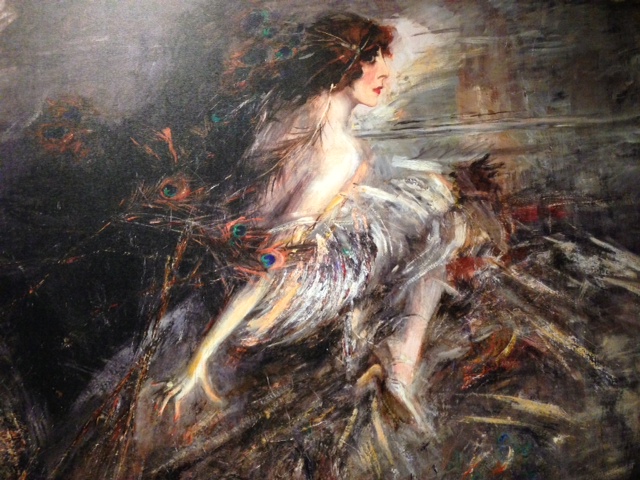
Once upon a time there was a bizarre lady living in Venice who wore her pet boa constrictor around her neck, walked her cheetahs on a leash in St. Mark’s Square with her Nubian servant Garbi following behind holding a peacock feather parasol over her head.
She was the Marquise Luisa Casati, a flamboyant, extravagant woman who used her vast wealth to make herself into a living work of art.
I had never heard of Luisa Casati until a few months ago when a heavy package arrived for me in my office containing a large catalogue for an exhibit in Venice called “La Divina Marchesa,” which has brought together some of the many works of art representing the Marquise Luisa Casati. As I flipped through the catalogue I became steadily more intrigued by this narcissistic woman who moved in the wealthiest circles in Europe and passed from the Belle Époque through the Roaring Twenties throwing lavish costume parties and dabbling in the occult.
This woman lived through two world wars without seeming to have taken much notice.
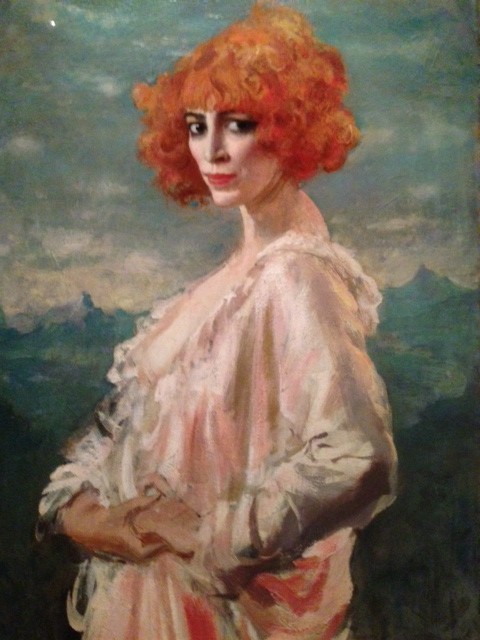
Luisa Casati was a distinctive and attractive woman – tall and slender, with big dark eyes. But she was not beautiful in a classical sense. Early on the Marquise decided she wanted to stand out. She began dyeing her hair carrot red, using dark kohl all around her eyes to create a rather raccoon effect, and she regularly used poisonous Belladonna eye drops to make her pupils seem seductively enormous. She then covered her face with powder so she had a ghostly pallor.
She didn’t bother hanging around with her husband very long, and sent her only child off to boarding school while she gallivanted around the world throwing fabulous parties and having herself painted by the world’s most famous artists.
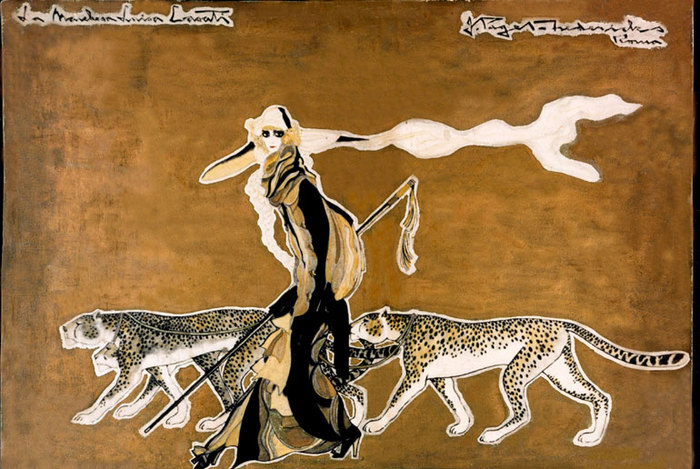
For some time the Marquise Casati rented the Palazzo Vernier dei Leoni in Venice and used it for her extravaganzas. The gardens were filled with her private zoo—her cheetahs, snakes, parrots, peacocks and monkeys. These animals would frequently accompany her about in her private gondola. Naked servants painted gold and holding lanterns would wait to greet the guests arriving by canal at her Palazzo for a party.
The Palazzo Venier dei Leoni was later bought by American art collector Peggy Guggenheim and turned into a museum.
Famed portrait artist Giovanni Boldrini was the first to paint la Casati at his studio in Paris. She took up residence at the Hotel Ritz while doing the sittings for the portrait.
While at the Ritz, Casati got to know Catherine Barjansky, a famous sculptress who was asked to make a wax figure sculpture of the Marquise. Barjansky wrote of Casati in her book, “Portraits and Backgrounds” “She had an artistic temperament, but being unable to express herself in any branch of art, she made an art of herself. Because she possessed no inner life nor any power of concentration, she sought wild ideas in her external life.”
Barjansky happened to be staying at the Ritz in Paris along with Casati when World War I broke out on August 4, 1914. Barjansky had this to say about Casati who descended to the lobby in a tizzy when no one responded to her call for breakfast, “I found the Marquise Casati screaming hysterically…Her red hair was wild. In her Bakst-Poiret dress she suddenly looked like an evil and helpless fury, as useless and lost in this new life as the little lady in wax. War had touched the roots of life. Art was no longer necessary.”
(Barjansky – Portraits in Backgrounds — quoted in Casati Biography cited below)
The Marquise moved in circles with the rich and famous of her generation. Here is a description by dancer Isabella Duncan of a visit to the Villa of Luisa Casati in Rome from her autobiography “My Life” (as cited in Casati’s biography see below)
“I went to the palace and walked into the antechamber. It was all done out in Grecian style and I sat there awaiting the arrival of the Marquesa, when I suddenly heard the most violent tirade of the most vulgar language you would possibly imagine directed at me. I looked around and saw a green parrot. I noticed he was not chained. I got up and leaped into the next salon. I was sitting there awaiting the Marquesa when I suddenly heard a noise–brrrrr–and I saw a white bulldog. He wasn’t chained, so I leaped into the next salon, which was carpeted with white bear rugs and had bear skins even on the walls. I sat down there and waited for the Marquesa. Suddenly I heard a hissing sound. I looked up and saw a cobra in a cage sitting up on end and hissing at me. I leaped into the next salon, all lined with tiger skins. There was a gorilla, showing his teeth. I rushed into the next room, the dining room and there I found the secretary of the Marquesa. Finally the Marquesa descended for dinner. She was dressed in transparent gold pyjamas. I said:
“You love animals,I see.”
“Oh yes, I adore them–especially Monkeys,” she replied looking at her secretary.
Strange to say, after this exciting aperitif, the dinner passed off with the utmost formality.” –Isadora Duncan, My Life
Over the decades Luisa Casati’s behavior became steadily more outlandish and her parties more extravagant. She would dress up as the Countess of Castiglione or as an American Indian Chief, Cagliostro, Cesare Borgia, or the Queen of Sheba.
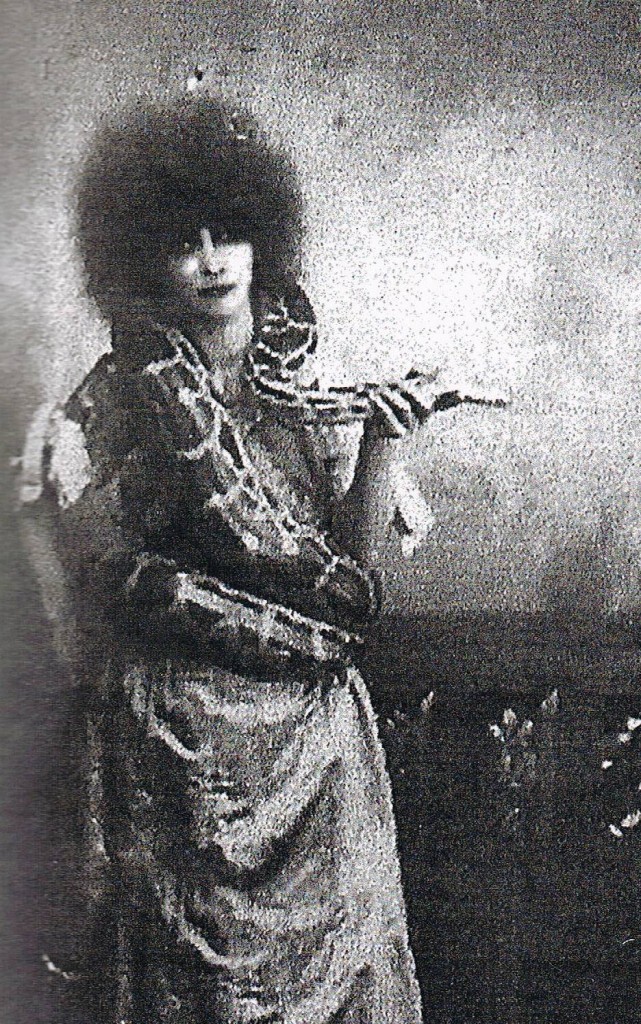
Other artists who painted, sculpted or photographed the Marquise Casati include Augustus Edwin John, Romaine Brooks, Joseph Rous Paget-Fredericks, Federico Beltran Masses, Sarah Lipska, Paolo Troubetzkoy, Leon Bakst, Mariano Fortuny Y Madrazo, Jacob Epstein, Ignacio Zuloaga, Kees Van Dongen, Giacomo Balla, Alberto Martini, Man Ray, Adolph De Meyer, and Cecil Beaton.
In her lifetime she would be considered the Muse of various artistic movements including the Symbolists, the Fauves, the Futurists and the Surrealists.
Although Luisa Casati biggest love affair was with herself – she did have romantic involvements with various men. Perhaps her most intense and longstanding relationship was with Italian writer and poet Gabriele D’Annunzio. D’Annunzio called her Core’, the Goddess of Hell—a name she clearly relished.
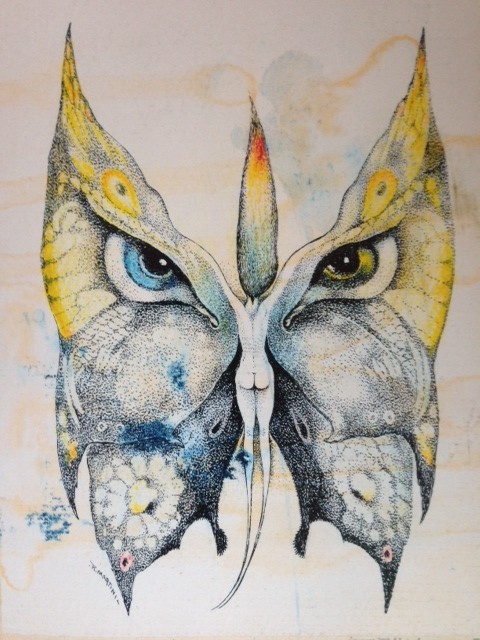
Casati inherited a massive fortune from her father who was in the cotton business and over the course of her lifetime managed to burn through it all and find herself in massive debt. She died in poverty in London in 1957. Her style however has left a mark on the fashion industry. In 1998 John Galliano said that the Marquise Casati was the inspiration for the wildly successful Dior Haute Couture spring/summer collection. Since then designers Karl Lagerfeld and Tom Ford credited Casati styles for inspiring their collections.
As I walked through the exhibit at Palazzo Fortuny in Venice I tried to understand this peculiar woman. It is hard for me to approve of a person with such vast wealth blowing it all on extravagant parties and funding artists to paint pictures of her and nothing else. It is also hard for me to approve of a mother sending her child off to a strict French boarding school in a Catholic Convent while she was traipsing around the world enjoying herself. I wondered if I would be so judgmental if the person involved was a man rather than a woman.
But despite my qualms about La Casati, there is no doubt that she continues to captivate and inspire, leaving her mark on the world of art and fashion.
(In addition to all the documents provided by the Exhibit, I got a lot more information reading the excellent, exhaustingly-researched biography of Luisa Casati “Infinite Variety: The Life and Legend of the Marchesa Casati” by Scot D. Ryersson and Michael Orlando Yaccarino)

. . hard to know what to say about such a person and such a life apart from ‘if you’ve got it, flaunt it!’
She definitely had it, and she spent her life flaunting it!!
Fascinating story! And I wonder what her relationship to the Church was, whether she was denounced, or adroitly made enough donations to buy their silence? And what a boring life – I mean, how many parties are tiresome before they are over, and to have a life of nothing but parties, the big splashy kind where no one really talks about anything to anyone, seems a bit hellish to me. So I wonder what a psychiatrist would say was her motivating impulse. The narcissism is classic, but why the outlandish look? And what do those wild animals represent? Perhaps, herself, for she was as exotic as they, and may have felt as trapped as they, in a prison of luxurious boredom. And what happened to them when she went broke? Miserable as a childhood in an institution sounds, it may have been better for the child than living with her – – – –
Interesting that you mention the Church — clearly she stayed far away from the Catholic Church, however, the biography I read mentions that in 1924 she obtained a divorce from her husband and it says: “With this act, some sources claim, the Marchesa became the very first Italian Roman Catholic Divorcee'”. Now there is a little interesting fact– I imagine a fair amount of money went into that happening, especially since divorce was not legalized in Italy until 1974 (hard to believe, but true). As far as her animals were concerned, after they died she had them stuffed and displayed in strange ways in her various homes and tried to fool people into thinking they were real. For example, for her palatial residence on the outskirts of Paris– the Palais Rose– she had a stuffed black panther that was controlled electronically and moved its tail and head. It would growl ferociously and its green eyes would light up. Interestingly, this panther was the inspiration for Cartier’s green-eyed panther jewels. Casati’s more exotic animals died off before she became completely bankrupt — but she held on to some Pekinese dogs which she also had stuffed when they died. One of these was put in her coffin with her. So, I guess as you suggest, she was trapped like her animals to the very end.
A private zoo, painted servants, a palazzo in Venice! What a fantastic story. I have never heard of Luisa Casati, and I must have completely missed the description in Isadora Duncan’s “My Life.” I guess the day of such larger than life characters are long over. What a life she led. How ever did she manage to get through WW II? Thank you for the insight. This was a heck of a breakfast read!
The life of Luisa Casati really makes a fantastic story and I would never have heard of her either if that catalogue for the exhibit had not been sent to my office. I am so glad I had a chance to learn about her and I think I am secretly envious of her crazy no-holds-barred life.
Wow! What a character! And brava for asking if you’d be so judgmental of a man. I’m guessing many people wouldn’t bat an eye. So while I agree the child abandonment part sucks, I love that she was so incredibly wild and free. Thank you for sharing her story!
Thanks Michelle — yeah, I am sure many people would not have bat an eye if she had been a man. And it is pretty cool that she was so totally wild — with her own traveling jungle!
Wow, what a wild and eccentric character. I had never heard of her, so thanks for bringing Mrs. Casati to my attention. I wonder how her child turned out in adulthood. I loved the painting of her with the red hair – very striking. I would love to get back to Venice again and revisit the Fortuny palazzo. I remember the first time I was there it was closed, but I pleaded with the caretaker to let me in (“I’ve come from America just to see Fortuny’s home,” etc.) and he did! A private tour ensued.
Hi Linda — thanks for your comment. Since you ask about her daughter, Cristina, I read in “Infinite Variety” — the biography of Luisa Casati, that her daughter studied Literature at Oxford and then became a “communist”. She married Viscount Hastings (an emerging artist who shared her communist sympathies) and they took off for Mexico where they became friends with Diego Rivera and Frida Kahlo. Cristina and Viscount Hasting eventually divorced and Cristina married Wogan Philipps, who had the title Lord Milford and was a member of the British Communist party. Cristina died at age 51 of breast cancer. Her mother did not attend her funeral. Interestingly, while she was ill, Cristina recorded hours of audio tape about her life. Her husband destroyed the tapes after she died– so we will have to imagine what Cristina might have had to say about her mother, surely it was not great.
Wow. What a character! Thank you for the dip into the pool of extravagance and the ridiculous….and yet another book to add to my pile.
Definitely was extravagant and ridiculous and so far from any reality I can think of. I was trying to come up with a modern comparable figure and had great difficulty.
So fascinating Trish! As a fellow Mozzarella Mamma I don’t condone either abandoning her child, but how brave and a role model in a twisted way with her divorce and selfish life.
I wonder what two WW would do to our values: would it make sense to love and nourish and cherish?
Partying throughout the two WW, isolate yourself from all the horrors and avoid any emotional ties doesn’t sound like a bad plan to me after all!
Hi Allegra — you are right in a sense. If you had all the money in the world, it would be tempting to run away from all the horrors of the two World Wars. Either you get involved and try to help — which she seemed completely incapable of doing– are you run away and have fun.
Wow, what a story! and I have never heard of her either! Would love to hear what happened to her child.
Hi Bonnie — see my above response to the comment from Linda with a brief explanation of what happened to her daughter. Interestingly, her daughter became a “communist” but married a “Viscount” and a “Lord” and had a pretty cushy life herself, so despite her rejection of her mother’s frivolous ways, she clearly developed an attachment to money. Interestingly, Casati’s granddaughter Lady Morea Black (her daughter’s daughter) was very supportive of the biography of Casati “Infinite Variety.”
How does someone ever get to be that crazy? One has to assume she left a stream of woe; children, animals etc, behind her. If one took the time I’ll bet you could identify others, both M and F, who lived similar lives. Finding parallels just isn’t worth the time!!
Once again a very interesting blog on a little know subject.
L/D
I think she left some unhappy animals and an unhappy daughter behind (actually her daughter died before she did), but I think her parents were relatively normal– wealthy Italian upper class, and her husband was pretty good and looking after himself. The only family member that Luisa Casati seemed to have a decent relationship with was her sister, Francesca, but after he sister got meningitis and was permanently disfigured, Luisa Casati no longer wanted her attending her parties. Nice lady.
I wonder if Lady Gaga was familiar with the Marquis?
Ah hah!! I ‘ve been trying to think of a modern day personality who might be comparable to the Marquise Casati and was coming up with nothing. Lady Gaga — that sounds about right.
Holy batsh*t, Trisha,! What a story!!! Who in the world uses belladonna drops in their eyes!?!?! You know, the Fortuny museum has some very interesting exhibits. I would be interested in knowing where her wealth originated from and how it was sustained giving her extravagance. Also, how did she die? I will definitely check out the book….great post, Trisha! Utterly fascinating!
She died in 1957 at age 76 of a cerebral hemorrhage. She was living in London in virtual poverty– with some old friends helping her out. The Belladonna drops thing is really weird. The biography quoted people saying her eyes were as red as her dyed hair by the end because she had destroyed them with those drops. I know nothing about the Fortuny Museum — I just took an hour to whip through to see the exhibit while I was in Venice covering Carnevale — but I will pay more attention now. As far as her money is concerned — I did not figure that one out. She inherited an huge about of money from her father who owned a cotton factory near Milan — but it is difficult to imagine that she could have had so much to go on for so long just throwing away money. Apparently by 1930 she was 25 million dollars in debt and had to sell off everything she had but then had no clue how to live with nothing. Apparently she would get in taxis in London and demand the driver spend hours driving her around and then would say she would pay later, or pull off her scarf and offer it. Of course, by then her scarves were old and worn out and the taxi drivers would not take them.
That is a fascinating story. Thank you for the answers to this wondrous life. Could not imagine being $25 million dollars in debt at age 25 in the year 1930!?!?! What would $25 million dollars THEN be comparable to NOW? Just WOW?!?! Can you image handling that kind of debt at 25 years old? It is like this woman lived in a dual reality. I am going to have to read up more now.
I am glad you discovered that little treasure of a museum – The Fortuny. I saw a magnificent collection of samurai armour (the largest outside of Japan) that was from a collector from Milan shown there a few years ago and it was stunning. The Fortuny has some really interesting and well curated exhibits and it is a great setting with few crowds.
She looks like Alice Cooper in the snake pic…
Ha!! I think you are right. Pretty Scary. She was a bit of a spooky lady.
Another great tale, Trisha, thanks… it seems everyday was Carnival for Luisa, with attendant license…